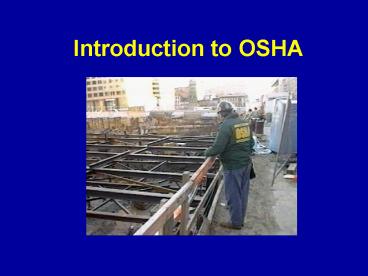Introduction to OSHA - PowerPoint PPT Presentation
1 / 11
Title:
Introduction to OSHA
Description:
Federal and State area offices. Speakers, publications, a/v aids, technical advice ... File a complaint about a workplace hazard. Request information on OSHA ... – PowerPoint PPT presentation
Number of Views:30
Avg rating:3.0/5.0
Title: Introduction to OSHA
1
Introduction to OSHA
2
What is OSHA?
- Occupational Safety and Health Administration
- Responsible for worker safety and health
protection
3
Is there a need for OSHA?
Each year...
- Nearly 6,000 workplace fatalities
- 50,000 deaths from workplace-related illnesses
- 5.7 million non-fatal workplace injuries
- Injuries alone cost U.S. businesses over 125
billion
Source - OSHA Publication 2056
4
Has OSHA Made a Difference?
YES!
Since 1970 OSHA has
- Helped cut the work-related fatality rate in half
- Worked with employers and employees to reduce
workplace injuries and illnesses by 40 - Virtually eliminated brown lung disease in the
textile industry, and - Reduced trenching and excavation fatalities by 35
5
What does OSHA do?
- Encourages employers and employees to reduce
workplace hazards and implement new or improve
existing safety and health programs - Develops and enforces mandatory job safety and
health standards - Maintains a reporting and recordkeeping system to
monitor job-related injuries and illnesses - Provides assistance, training and other support
programs to help employers and workers
6
Who is covered by the OSH Act?
- Most private sector employees
- Coverage is provided directly by federal OSHA or
through an OSHA-approved state program - Does not cover the self-employed or immediate
members of farm families that do not employ
outside workers
7
- OSHA Standards
- OSHA develops and enforces standards that
- employers must follow.
- Where OSHA does not have standards,
- employers are responsible for following the
- OSH Act's General Duty Clause.
- States with OSHA-approved programs must
- set standards at least as effective as federal
- standards.
8
Sources of Assistance
- OSHA web site (www.osha.gov)
- Consultation assistance
- Federal and State area offices
- Speakers, publications, a/v aids, technical
advice - Training and education
- OSHA Training Institute (OTI) and the OTI
Education Centers - OSHA Outreach Training Program
- OSHA Office of State Programs
- Voluntary Protection Programs
9
OSHA Web Site(www.osha.gov)
- About OSHA (events, whats new . . .)
- Compliance Assistance (regulations, directives,
consultation, eTools, training . . .) - Cooperative Programs (VPP, partnerships )
- News Room (publications, news releases . . .)
- Safety / Health Topics (technical links to
various topics) - Statistics (Inspection data, BLS survey link ...)
10
OSHA Emergency Hot-Line1-800-321-OSHA
- Report workplace safety or health fatalities or
the hospitalization of 3 or more employees - Report a workplace hazard
- File a complaint about a workplace hazard
- Request information on OSHA
- Request an OSHA publication
11
Summary
- OSHA helps save lives and prevent injuries
- OSHA balances a cooperative approach with
traditional enforcement - OSHA standards are the enforceable requirements
for worker safety and health - Inspections are OSHAs way to ensure compliance
- OSHA offers various means of assistance































